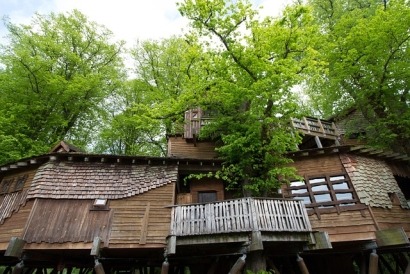
Sedentary lifestyles have become much more common in recent decades — you can find hints of this disturbing trend in modern construction. Elevators and escalators appear just as frequently as staircases. Air pollution from urban construction makes people more likely to stay inside. Increased urbanization makes sidewalks, parks and recreation facilities less common.
Building sustainably can help us address all of these problems. Returning to staircases reduces a building’s energy expenditure and encourages the occupants to stay active. Using eco-friendly materials reduces pollution from construction projects and makes the outdoor environment more hospitable.
Some cities have even implemented new design strategies to free up more exercise space and improve the locals' health. For example, New York City’s active design guidelines seek to increase the city’s mobility and reduce vehicle emissions with more walkways and cycling paths. You might have noticed more cycling paths and other exercise initiatives in your own city.
Sustainable construction and active lifestyles go hand in hand. By using natural, non-toxic materials and creating more wide-open spaces that allow the ecosystem to flourish, builders enable communities to get outside, exercise and stay healthy.
Due to the higher prevalence of sedentary lifestyles, people spend most of their time indoors. That means they face constant exposure to dust, smoke, mold, volatile organic compounds and many other air pollutants from low-quality building materials. As a result, chronic respiratory illnesses have become 39.5% more common in the last few decades.
There also tends to be less oxygen indoors due to limited ventilation, which restricts our ability to breathe. This factor can cause symptoms like nausea, headaches, confusion and even loss of consciousness.
Sustainable building can help us avoid these health issues by improving indoor ventilation and removing toxic substances from the air. The new standards are materials from suppliers who are members of certified conservation groups such as GreenGuard and the Forestry Stewardship Council. Air quality tests are also now essential parts of the construction process.
Air purification helps people avoid respiratory problems and even improves our cognitive functions. It has been shown to improve academic performance in the classroom and job performance in the workplace. It’s more important than ever to ensure your home’s air quality with the potentially lethal respiratory virus COVID-19 still around.
Less sunlight exposure has been another consequence of spending more time indoors. Buildings are full of dim artificial light, which is not an adequate replacement for sunlight. Lack of sunlight exposure can cause essential vitamin deficiencies, poor skin health and erratic sleep patterns.
Humans also need sunlight to balance their circadian rhythms and produce the essential hormone serotonin. This hormone helps us regulate our moods, emotions and appetites. Getting at least 30 minutes of sunlight is crucial to a healthy daily routine.
Sustainable building is helping sunlight make a comeback. Skylights and window walls are increasingly popular in both residential and commercial spaces. New alternatives like task lighting, blue-enriched light and full-spectrum bulbs that mimic the effects of sunlight more closely are also gaining momentum.
The more natural light you can bring indoors, the less you have to rely on artificial fixtures. That means you consume less energy from electricity and spend less money on utilities. Prioritizing sunlight benefits your health, the environment and your wallet.
Self-sufficiency is one of the hallmarks of sustainable construction. If a building has its own electricity, water and food supplies, it consumes much less energy and leaves a smaller environmental footprint. It also enables us to eat healthier. Instead of buying food packed with artificial ingredients, you can cultivate your own healthy food products.
For this reason, fruit and vegetable gardens have become one of the calling cards of sustainable urban architecture. They create green, open spaces while providing residents with healthy dietary options. You can find them in public courtyards, on rooftops and in people’s backyards.
On a community level, building sustainably makes us more prepared to deal with natural disasters. Extreme weather events have become more common in recent years as climate change progresses, making emergency preparedness a higher priority for building designers and city planners.
Architects are using more durable natural materials instead of cheap artificial materials to strengthen their buildings against harsh weather. The United Nations offers many helpful guidelines, including making sure buildings can anticipate and adapt to whatever disaster may strike.
Perhaps most importantly, a healthy, active populace is better equipped to handle disasters than an unhealthy, sedentary populace. All the efforts to improve air quality, promote exercise, increase sunlight exposure and provide healthy food options make us more prepared to deal with natural disasters.
All these efforts to build more sustainably also improve our mental health. When you can breathe clean air, get enough sunlight and exercise daily, you are bound to be happier. An active lifestyle is essential for warding off depression and maintaining a sense of purpose.
Making our architecture resemble nature also has significant positive effects on our psyche. Humans are designed to live outdoors, in wide open spaces surrounded by lush greenery. Incorporating more natural design elements betters our psychological health by bringing us back to more familiar environments.
As construction becomes more sustainable, social climate anxiety will also decrease. Climate anxiety has been a massive factor in the rise of mental health problems among young people, especially children. If our communities are less destructive to the environment, these feelings of anxiety and guilt will decrease.
Sustainable building enables us to exercise more often, improves the air we breathe, gives us more sunlight exposure, helps us eat healthier and lightens our mental burdens. Sustainability restores the balance between humans and the environment. The healing process might be slow, but every day of positive change brings us one step closer.

